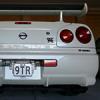A must see for all performance enthusiasts!
Announcements
-
Similar Content
-
Latest Posts
-
By GoHashiriya · Posted
Cheers. Skyline is back on the menu, can’t get rid of it. It’s like a child you don’t want, or herpes -
By Dose Pipe Sutututu · Posted
Welcome back brother -
By GoHashiriya · Posted
I got back to Japan in January and was keen to get back on track as quickly as possible. Europe is god-awful for track accessibility (by comparison), so I picked up a first-gen GT86 in December just to have something I could jump into right away. The Skyline came over in a container this time and landed in early January. It was a bit battered after Europe, though—I refused to do anything beyond essential upkeep while it was over there. The clutch master cylinder gave out, and so did the power steering. I didn’t even bother changing the oil; it was the same stuff that went in just before I left Japan the first time. Naughty. Power steering parts would’ve cost double with shipping and taxes, so knowing I’d be heading back to Japan, I just postponed it and powered through the arm workout. It took a solid three months to get the car back on the road. Registration was a nightmare this time around. There were a bunch of BS fees to navigate, and sourcing parts was a headache. I needed stock seats for shaken, mistakenly blew 34k JPY on some ENR34 seats—which, of course, didn’t fit—then ended up having the car’s technical sheet amended to register it as a two-seater with the Brides. Then there’s the GT86. Amazing car. Does everything I want it to do. Parts are cheap, easy to find, and I don’t care what anyone says—it’s super rewarding to drive. I’ve done a few basic mods: diff ratio, coilovers, discs, pads, seat, etc. It already had a new exhaust manifold and the 180kph limiter removed, so I assume it’s running some kind of map. I’ve just been thrashing it at the track non-stop—mostly Fuji Speedway now, since I need something with higher speed after all that autobahn time. The wheels on the R34 always pissed me off—too big, and it was a nightmare getting tires to fit properly under the arches. So I threw in the towel and bought something that fits better. Looks way cleaner too (at least to me)—less hotboy, less attention-seeking. Still an R34, though. Now for future plans. There are a few things still outstanding with the car. First up, the rear subframe needs an overhaul—that’s priority one. Next, I need to figure out an engine rebuild plan. No timeline yet, but I want to keep it economical—not cutting corners, just not throwing tens of thousands at a mechanic I can barely communicate with. And finally, paint. Plus a bit of tidying up here and there. -
Nope, needed to clearance under the bar a little with a heat gun, a 1/2" extension as the "clearancer", and big hammer, I was aware of this from the onset, they fit a 2.0 with this intake no problems, but, the 2.5 is around 15mm taller than a 2.0, so "clearancing" was required It "just" touched when test fitting, now, I have about 10mm of clearance You cannot see where it was done, and so far, there's no contact when giving it the beans Happy days
-
By GoHashiriya · Posted
It's been a while since I've updated this thread. The last year (and some) has been very hectic. In the second-half of 2024 I took the R34 on a trip through Germany, Italy, France and Switzerland - it was f*cking great. I got a little annoyed with the attention the car was getting around Europe and really didn't drive it that much. I could barely work on the car since I was living in an inner-city apartment (with underground parking). During the trip, the car lost power steering in France - split hose - and I ended up driving around 4,000kms with no power steering. There were a few Nurburgring trips here and there, but in total the R34 amassed just shy of 7,000kms on European roads. Long story short, I broke up with the reason I was transferred to Europe for and requested to be moved back to Japan. The E90, loved it. It was a sunk cost of around EUR 10,000 and I sold it to a friend for EUR 1,500 just to get rid of it quickly. Trust me, moving countries f*cking sucks and I could not be bothered to be as methodical as I was the first time around.
-








Recommended Posts
Create an account or sign in to comment
You need to be a member in order to leave a comment
Create an account
Sign up for a new account in our community. It's easy!
Register a new accountSign in
Already have an account? Sign in here.
Sign In Now